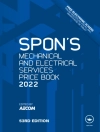This book highlights recent advancements and innovations in trenchless technology via the adoption of combined micro-tunnelling and pipe-jacking techniques. This technique is more environmentally friendly, cost effective, less time-consuming and less disruptive compared to conventional open trench excavations for urban construction and urban infrastructure renewal projects. Pipe jacking is a non-destructive technique used in the installation of underground pipelines using a tunnel boring machine (TBM) and thrust forces derived from the hydraulic jack set-up in a deep jacking shaft. It is popular and commonly used worldwide for the installation of sewer and common services cable tunnels as well as for oil and gas pipelines.
Содержание
Chapter 1: Introduction — Trenchless technology in an urban environment.-
Chapter 2: Greening the urban infrastructure and construction methodologies.-
Chapter 3: Site investigation techniques for micro-tunnelling via pipe jacking method.-
Chapter 4: Characterisation and interpretation of geologies for pipe jacking work.-
Chapter 5 : Complex soil-pipe interaction challenges that impact project timeline and deliverables.-
Chapter 6: Mechanistic behaviour and maintenance challenges of a tunnel boring machine (TBM) affecting jacking performance.-
Chapter 7: Innovations and challenges faced in construction of deep shafts for TBM launch and retrieval.-
Chapter 8: Innovative long-distance and curved pipe-jacking drives.-
Chapter 9: Innovative non-conventional large diameter or non-circular jacking technology.-
Chapter 10: Advances in damage assessment, rectificaton and maintenance for pipe-jacking works.
Об авторе
Dr Ong obtained his Bachelor of Civil Engineering Degree from The University of Western Australia (UWA) in 1998 and his Ph.D. from the National University of Singapore (NUS) in 2004. His research interests are in soil–structure interaction, deep excavation, tunneling, ground improvement, numerical & centrifuge modelling, and field observational methods. He is currently the President of the Malaysian Geotechnical Society (MGS), Senior Lecturer at Griffith University, Australia and Adjunct Associate Professor at Swinburne University of Technology. He is Fellow and Chartered Professional Engineer of both Engineers Australia (EA) and the Institution of Engineers Malaysia (IEM). He is also currently Joint Editor-in-Chief of the UK’s Institution of Civil Engineers (ICE) journal, Geotechnical Research, and sits in the International Society for Soil Mechanics and Geotechnical Engineering (ISSMGE) Technical Committee TC104 Physical Modelling in Geomechanics and TC207 Soil-Structure Interactionand Retaining Walls.
Dr Marco Barla is Associate Professor at Politecnico di Torino, Italy, teaching ‘Numerical methods in geotechnical engineering’ and chairing the research group in the areas of rock mechanics, tunnelling and slope stability. He edited one book and over 150 scientific papers and holds a patent of an energy tunnel segment (Enertun). He also acts as a consultant in geotechnical engineering on projects related to slope stability, tunnelling, sewage systems, foundations, monitoring of geotechnical structures and radar interferometry. He is the Editor-in-Chief of the ASCE International Journal of Geomechanics and member of the Editorial Board of Tunnelling and Underground Space Technology and of Soils and Rocks. Dr Cheng obtained his Master’s and Ph.D. Degrees in Geotechnical Engineering in 2005 and 2010, respectively, from the National Taipei University of Technology. His interests in research cover tunnelling and trenchless technologies, contaminated site remediation, and biomineralisation methods. He is currently the Council Member of the Chinese Society for Rock Mechanics and Engineering (CSRME), Shaanxi Society for Rock-Soil Mechanics and Engineering (SXRSME), and Professor at Xi’an University of Architecture and Technology. He also sits in the International Society for Soil Mechanics and Geotechnical Engineering (ISSMGE) Technical Committee TC213 Scour and Erosion and the Institue of Materials, Minerals and Mining (IOM3) Chartered Engineer Assessor Committee.
Dr Choo obtained his BEng (Civil Engineering) (1st Class Honours) in 2010 and subsequently his Ph.D. in 2015, both from Swinburne University of Technology in the field of geotechnical engineering, focusing on micro-tunnelling in the form of pipe jacking. His research interests include rock characterisation, trenchless technologies, deep learning in tunnelling, discrete element modelling of soil behaviour, and geo-education. He is currently a Senior Lecturer at Swinburne University of Technology, Sarawak Campus, as well as being the Chairman for the Youth Wing of the Malaysian Geotechnical Society (MGS). He is a Chartered Professional Engineer (CPEng) registered with Engineers Australia. Dr. Choo is currently a nominated member of Technical Committees under the International Society for Soil Mechanics and Geotechnical Engineering (ISSMGE), namely TC105 Geo-Mechanics from Micro to Macro, and TC309 Machine Learning and Big Data.
Ms. Minmin Sun obtained her Bachelor of Civil Engineering Degree from Lanzhou University of Technology, China in 1982 and Master Degree of Project management from the Heriot- Watt University, UK in 2008. She is currently a director of W&M consultants, Singapore, the chairperson at Singapore Society for Trenchless Technology, a supervisor of Post Graduate students from the Xi’an Jiaotong University, China and adjunct lecturer of Universiti Teknologi Petronas, Malaysia. She has gained valuable experience in the trenchless industry through her working experience spanning over 3 decades in regions of China, Singapore, the Middle East, Vietnam and Cambodia.
Mr. Peerun graduated from Swinburne University of Technology with a Bachelor’s Degree in Civil Engineering in 2013 and Master of Engineering by Research in 2016. His research areas are in tunnelling technology and pipe-jacking, geomechanics testing, image processing using PIV technology and discrete element modelling. He is currently a Ph.D. scholar at Griffith University where his current research aims at studying interface shearing using synthetic particles for the application of tunnelling technology.












